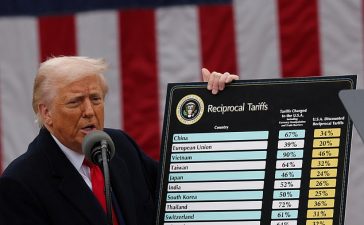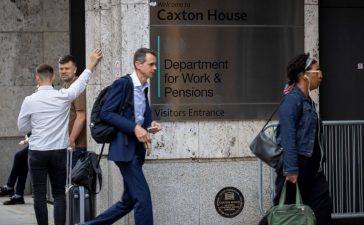Stay informed with free updates
Simply sign up to the Chinese business & finance myFT Digest — delivered directly to your inbox.
China’s biggest private sector developer, Country Garden, appears to be heading for default after failing to make a payment on an offshore bond — another critical moment in the slow reckoning taking place in the country’s vast property sector.
Two years ago it was the default of another developer, Evergrande, that encapsulated concern over the scale of problems in Chinese property. Evergrande had racked up $340bn of liabilities and become the world’s most indebted property developer.
Country Garden was long thought more stable but its problems now show both the deterioration in the sector — with sales drying up and thousands of stalled developments across China — and the difficulties for Beijing in getting to grips with a long crisis that has shaken the world’s second-largest economy.
“China is struggling to strike a balance on its property policy over the past two years — they have been caught between providing too much stimulus or not enough,” said Larry Hu, chief China economist at Macquarie. “They have been muddling through — but the measures they have taken so far have been not enough to ease the developer-related credit risk perceived by homebuyers.”
The turmoil among property developers is hugely significant for China because construction and real estate has been the motor of much of its growth. Property and related industries have often contributed roughly a quarter of gross domestic product.
Country Garden reiterated last week that it “will not be able to meet all of its overseas debt repayment obligations”. It has not made payment on a bond that was due in mid-September. A final, 30-day grace period for payment expired this week. The group has international debts worth of around $11bn and total liabilities of around $200bn as of the end of June.
Country Garden’s sales fell 44 per cent year-on-year in the first six months of 2022. The company’s shares have fallen around 70 per cent this year, while its bonds are trading at about 5 cents on the dollar.
The group is expected to join dozens of other developers in pursuing an offshore debt restructuring. But the status of their much larger mainland obligations, which include loans from banks and investment firms, remains shrouded in uncertainty.

Evergrande itself is still struggling to finalise its own long-planned restructuring, which was derailed last month when it failed to proceed with an offshore debt refinancing due to an unspecified regulatory investigation. Evergrande faces a liquidation hearing in a Hong Kong court on October 30.
The uncertainty over whether regulations have been changed risks “dragging other developers into the quagmire”, said Gary Ng, senior economist with Natixis in Hong Kong.
China’s real estate developers for years drew on offshore and onshore bond issuance to support their mainland development activity. Developers often sell apartments before they are completed, using the funds to invest in new developments elsewhere.
But when policymakers sought to restrict new borrowing with a strict “three red lines” policy in 2020, developers’ old fundraising model collapsed.
Most of the top 10 developers in 2020 have also faced plummeting sales amid waning consumer confidence, compounding developers’ liquidity concerns. There are signs that homebuyers have preferred instead to buy from state-backed developers, seen as less likely to go bust.
Trying to correct course, policymakers last November unveiled support measures for the property sector. Banks opened new credit lines to developers deemed of higher quality, including Country Garden. But they have so far failed to stop the liquidity crunch.
More than half of the biggest 50 developers in 2020 have now gone into default. Bloomberg figures show Chinese developers have defaulted on around $115bn of $175bn in outstanding offshore dollar bonds since 2021. A bigger pile of onshore bank loans also faces restructuring or rollovers.
As developers reel, Beijing and local governments have so far emphasised the need to complete unfinished housing projects. While there are no comprehensive figures on the number of unfinished developments, available data suggests the total has fallen since 2021 but remains higher than in most of the past two decades.
But the developers’ defaults raise questions over their ability to complete many of those projects.
The crisis for the real estate sector has yet to feed through into any sharp move for house prices. New home prices, the main gauge of the real estate market in China, have fallen in some major cities but remain buoyant in others.
This year the government has sought to offer more support for buyers. Lenders reduced interest rates that cover half of the country’s mortgage loans in September. Some major second and third-tier city authorities lifted all restrictions on housing purchases from July.
Analysts argue that many of Beijing’s policy measures towards property have been well-intentioned but ineffective — trying to strike too delicate a balance between offering enough liquidity support and not spurring further speculation in the sector.
“Many policies aim to stabilise the home market and provide just about the right amount of liquidity for developers to finish existing units and deleverage,” said Ng. “[But] when there are too many targets, it is a difficult task to ensure everything falls into place.”
“It’s part of a bigger problem that we see as well outside the property sector,” said Sandra Chow, co-head of Asia-Pacific Research at credit research firm CreditSights, referring to targeted funding to funnel credits to small and midsized companies. “The transmission of these policies was always the difficult part.”
Rory Green, chief China economist at TS Lombard, said China’s policymakers had appeared to have a good grasp of the need to cut leverage in property two years ago. “But what has gone wrong is not having a plan of how they are going to change it and what they are hoping to go towards a new model for the sector,” he said.
“It’s simply very difficult to suddenly shift growth model and try to reallocate resources away from property . . . particularly when it has massive asset linkages to household and to local governments, and to the entire financial system.”
















